ATI’s Crossfire: Best Overclocker on the Market?
by Wesley Fink on September 27, 2005 12:05 AM EST- Posted in
- CPUs
Disk Controller Performance
With so many chipsets and brands of storage controllers on current Athlon 64 boards, we needed a means of comparing performance of the wide variety of controllers. The logical choice was Anand’s storage benchmark first described in Q2 2004 Desktop Hard Drive Comparison: WD Raptor vs the World. To refresh your memory, the iPeak test was designed to measure "pure" hard disk performance, and in this case, we kept the hard drive as consistent as possible while varying the hard drive controller. The idea is to measure the performance of a hard drive controller with a consistent hard drive. We played back Anand’s raw files that recorded I/O operations when running a real world benchmark - the entire Winstone 2004 suite. Intel's IPEAK utility was then used to play back the trace of all the IO operations that take place during a single run of Business Winstone 2004 and MCC Winstone 2004. To try to isolate performance difference to the controllers that we were testing, we used Seagate 7200.7 model SATA and IDE hard drives for all tests.
iPeak gives a mean service time in milliseconds; in other words, the average time that each drive took to fulfill each IO operation. In order to make the data more understandable, we report the scores as an average number of IO operations per second so that higher scores translate into better performance. This number does not represent a hard disk performance parameter as it is just the number of IO operations completed in a second. However, the scores are useful for comparing “pure” performance of the storage controllers in this case.
With so many chipsets and brands of storage controllers on current Athlon 64 boards, we needed a means of comparing performance of the wide variety of controllers. The logical choice was Anand’s storage benchmark first described in Q2 2004 Desktop Hard Drive Comparison: WD Raptor vs the World. To refresh your memory, the iPeak test was designed to measure "pure" hard disk performance, and in this case, we kept the hard drive as consistent as possible while varying the hard drive controller. The idea is to measure the performance of a hard drive controller with a consistent hard drive. We played back Anand’s raw files that recorded I/O operations when running a real world benchmark - the entire Winstone 2004 suite. Intel's IPEAK utility was then used to play back the trace of all the IO operations that take place during a single run of Business Winstone 2004 and MCC Winstone 2004. To try to isolate performance difference to the controllers that we were testing, we used Seagate 7200.7 model SATA and IDE hard drives for all tests.
iPeak gives a mean service time in milliseconds; in other words, the average time that each drive took to fulfill each IO operation. In order to make the data more understandable, we report the scores as an average number of IO operations per second so that higher scores translate into better performance. This number does not represent a hard disk performance parameter as it is just the number of IO operations completed in a second. However, the scores are useful for comparing “pure” performance of the storage controllers in this case.
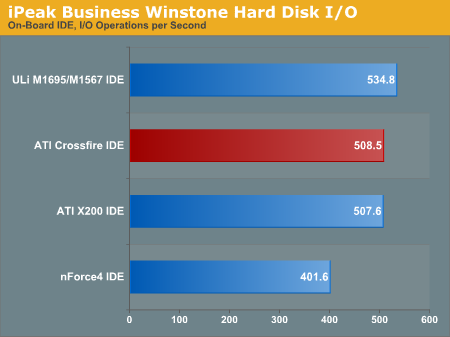
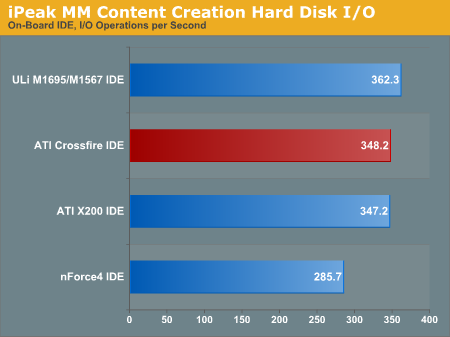
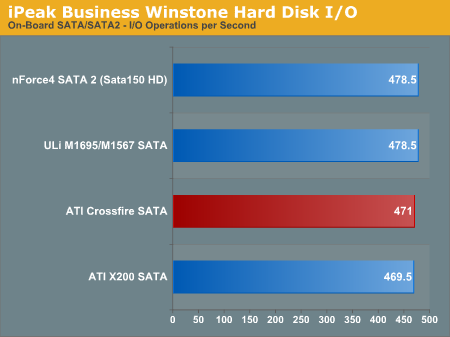
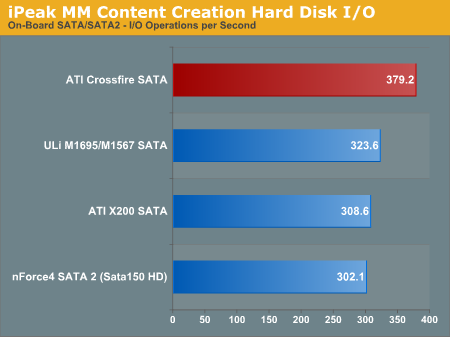
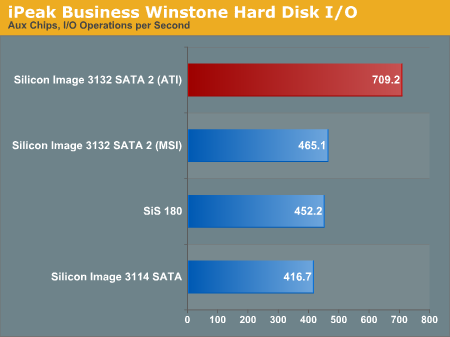
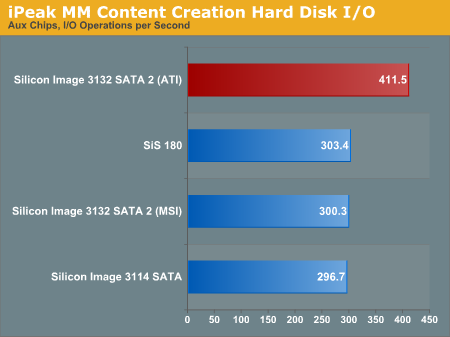










40 Comments
View All Comments
n00b1e - Tuesday, September 27, 2005 - link
Great article, but how about benchmarking real apps on the overclocked settings and comparing the result to the non-overclocked ones instead of just comparing the highest attainable memory/bus speed overclocks?Quanticles - Tuesday, September 27, 2005 - link
Another bought review..."The ATI Crossfire AMD has every option a serious overclocker could wish for."
How about the option to use a CRT? I like to use 1600x1200 at 85 Hz.
Wesley Fink - Tuesday, September 27, 2005 - link
A 7800GTX or X1800 can easily do 1600x1200 at 85 Hz - and probably outperform X850XT Crossfire. It's all a matter of perspective.In addition, Derek has already said the next gen (X1800), due out in less than 2 weeks, does not have this limitation in Crossfire mode. That's why he did not recommend Crossfire X850/X800 and said to wait a short while. THAT Crossfire solution will also work on this board.
ChronoReverse - Tuesday, September 27, 2005 - link
Red Herring. We're talking about the motherboard and how wellit can overclock the cpu). The graphics card is irrelevant (and the limitation on the xfire cards themselves not the motherboard).Myrandex - Tuesday, September 27, 2005 - link
2nd page:The various ATI Radeon Xpress 200 north bridges can also be combined with ULi south bridges. The current ULi 1573 provides all the features of the ATI BS450 except integrated Gigabit Ethernet.
should be SB450
Wesley Fink - Tuesday, September 27, 2005 - link
I have spoken witrh ATI and several mfgs this morning to update board availability. Between today and the 2nd week of October we should see RETAIL Crossfire motherboards appear from DFI, Gigabyte, ECS, MSI, Asus and a few others. RETAIL availability means you will be able to buy them at New Egg or other e'tailers at that time.X850XT Master Cards are expected to be for sale RETAIL tomorrow, September 28th, with X800 Master Cards several weeks away.
I have a Gigabyte Crossfire AMD in my hands as I write this. It is the release Vewrsion 1.0 board and I received the release BIOS this morning.
eastvillager - Tuesday, September 27, 2005 - link
"yeah, we know our usb performance sucks on SB400, we're fixing it in SB450""Yeah, we know our usb performance sucks on SB450, we're fixing it in SB600"
prediction:
"Yeah, we still don't have USB 2.0 working properly on SB600, wait till SB700, when USB 3.0 comes out and we'll be ok."
Kind of hard to understand how they can do just about everything else on the mobo correctly, but continually screw up USB 2.0. USB 2.0 is a commodity at this point, it is just suppose to work, with no worries, etc.
I use USB 2.0 on a daily basis, it really isn't an area I'm willing to slack on.
Leper Messiah - Tuesday, September 27, 2005 - link
Hm. I'm getting a new mobo soon (as in the next 2 weeks). Is this a paper launch, or will we see single slot solutions out there soon? nVidia has set a precedent with the instant availiblity and massive volume (relatively, I mean they're selling below MSRP for a reason) of their 7800 series. It could be more damaging than delaying the R520 if they don't have it and this mobo out STAT.Would be kinda funny though...for years I've run nVidia chipsets and ATi graphics. Looks like it might get reversed...
allnighter - Tuesday, September 27, 2005 - link
Agreed. Not that I'm referring to AT's conclusions being questionable in any way, shape or manner, I know they say what they see, but it's pretty much obvious that ever manufacturer/vendor simply handpicks any given piece of hardware that is sent to AT for review, since they all know that AT is pretty much the most trusted site. Although I appreciate early previews we get here, I'm a much bigger fan of reviews of retail products. That's about what you'll be able to buy, right away or in just a couple of weeks. Many of these reference pieces are on steroids and simply never materialize in real world performance.Other than that - a very good write up, as usuall.
TehSloth - Tuesday, September 27, 2005 - link
Well mates, this sure does look nifty, but remember what happened to the RS480, which also received Anand's accolades as the best overclocking reference board ever, they couldn't release it right. The Gigabyte board that they talk about in the article was never actually released, and I have a long chain of correspondence with them as it got pushed back more and more. MSI, ECS, and Jetway were the only manufacturers that delivered, and they disabled all the OCing options. Psshhhah!